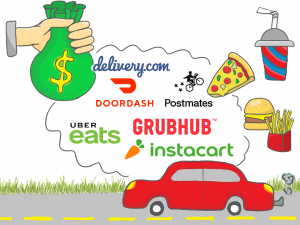Food delivery services drain wallets
March 10, 2021

Ordering food on delivery services such as DoorDash can mean you are paying up to 40% more than if you were ordering that same thing in person.
People in America have been spending unreasonable amounts of money on food delivery apps which have skyrocketed in business due to COVID-19. Why do people continue to spend more money on goods with jacked-up prices?
Restaurants in the past year of COVID-19 have been trying to adapt to the challenging times. For many, that meant transitioning sales to takeout and delivery.
The most convenient way for restaurants to do so has been by enlisting the help of third-party providers like DoorDash, GrubHub, Uber Eats, Seamless, Postmates, Instacart and other on-demand food delivery apps created for convenience.
According to Forbes, many people do not realize that after commissions and fees, these providers can cost consumers up to 40% more and can cost the restaurant up to 30% more.
These services have evidently been convenient for consumers, but they are draining people’s bank accounts.
As of December 2020, DoorDash was worth an upwards of $32 billion, according to CNBC, and is still growing.
Last week, my friend and I ordered Chick-fil-A from Doordash. We ordered a 12-piece chicken nugget, waffle fries, mac and cheese, a fruit cup, two small frosted lemonades and a cookies and cream milkshake.
This should have cost us around $25, but ended up costing $45 including the tip. DoorDash gets the bulk of its prices from inflating the costs of items, but the amount we ended up spending was insane just on seven small food items.
Back in June of 2020, the book series “Eat This, Not That!” a media franchise owned and operated by co-author David Zinczenko, shared that some delivery apps charged customers more by raising menu prices on the app without telling the restaurant.
This directly affects businesses and does not make the apps look good.
As great as food delivery services are for providing jobs for people and food being delivered in a very fast manner, there are often mistakes and mix-ups in orders.
Instead of the 12-piece chicken nugget order, we ended up getting a four-count chicken strip. The prices between these two options are very similar, so it was not a big deal, but it was a mistake.
Other issues with DoorDash and similar food delivery services include the apps being down, the cancellation of an order, drivers being handed the wrong order, delivering the wrong order and more.
If people want to support businesses, ordering from specific places is the best choice. In a survey from Influence Central, 60% of people who got delivery lately ordered directly from the restaurant. This ensures that all of the money the customer pays for the food goes directly to the restaurant and not given to greedy third parties.













